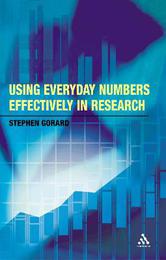
|
Using Everyday Numbers Effectively in Research
Paperback / softback
Main Details
| Title |
Using Everyday Numbers Effectively in Research
|
| Authors and Contributors |
By (author) Stephen Gorard
|
| Physical Properties |
| Format:Paperback / softback | | Pages:114 | | Dimensions(mm): Height 216,Width 138 |
|
| ISBN/Barcode |
9780826488305
|
| Classifications | Dewey:300.72 |
|---|
| Audience | | Undergraduate | | Postgraduate, Research & Scholarly | |
|---|
|
Publishing Details |
| Publisher |
Bloomsbury Publishing PLC
|
| Imprint |
Continuum International Publishing Group Ltd.
|
| Publication Date |
4 April 2006 |
| Publication Country |
United Kingdom
|
Description
Can you add up the number of students in your classroom? Can you tell which of two test scores is the larger? Can you programme a video or DVD recording using a 24-hour clock? If so, then this book will show you how everyday numbers like these can also be used to make your research more powerful, and enable you to spot the abuses of number that are as common in research as they are in everyday life. This book illustrates how numbers can be used routinely and successfully for research purposes - without you ever having to consider confidence intervals, probability densities, Gaussian distributions, or indeed any of those complicated and generally useless things that appear in treatises on statistics. This no-nonsense guide should prove essential reading for all educational and social science researchers.
Author Biography
Stephen Gorard is Professor of Education in the School of Education at the University of Birmingham, UK.
ReviewsIn this short book, Gorard (Univ. of York) argues against using traditional statistical methods in favor of "everyday numerical techniques" in social science research. His underlying theme is threefold: "using veryday numbers in research is easy," they "can lead to important research discoveries," and they inject "a necessary dose of critical realism into claims." Through numerous examples, Gorard attempts to demonstrate that using everyday number techniques is better and clearer in providing the analysis of research. His examples are based on actual data and studies in the educational system in Wales and England. Various areas of basic tatistical research techniques are argued against. Gorard discusses why the mean deviation is a better tool than the standard deviation. Two other areas of statistics that are disputed are the different "levels" of measurement and the use of significance tests. Overall, the book is a short exposition on why not to use traditional statistical methods in research while attempting to demonstrate other options. This book will provide social science researchers with thought-provoking ideas and possibly new ways of thinking about using numbers in their research. Summing Up: Recommended. Upper-division undergraduates through faculty. * Choice *
|